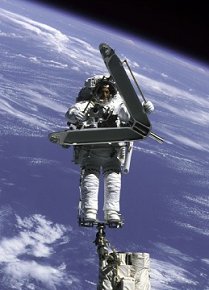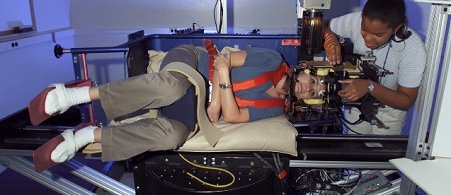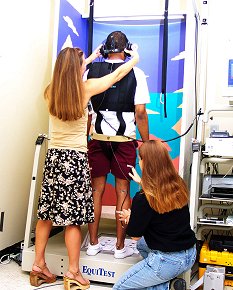|
Researchers are learning new things about
the human brain by studying how astronauts regain their balance.
by Karen Miller
Balancing is not as easy as it seems
- just try to stand on one foot for a full minute, and you'll get
a sense of the constant effort involved.
It's one of those complex skills like
reading that becomes so automatic with practice, we simply forget
how tricky they were to learn. And, like reading, you might suppose
it would take something extraordinary to make you forget.
Indeed it does. Like travelling to
space.
Researchers have found that astronauts
who return from a space voyage can still balance, but they find
it far more difficult. That's because, explains neuroscientist Bill
Paloski, their brains are no longer sure how to interpret the information
that comes from their senses.
When you balance, he says, you use
information from as many as three sources: the proprioceptive
sensors in your muscles, which tell you where your body parts
are in relationship to each other, the vestibular system
in your inner ear, which tracks the position of your head in space,
and of course your eyes.
The brain deals with all that information
by building "a model." Computer programmers might call it a mental
subroutine, but it's more than an algorithm. Models provide context
for interpreting and reacting to sensory data. The brain generates
such models all the time - it's the way we learn and adapt. We do
it on Earth, say, when we learn a new language, or even when we
get accustomed to new prescription glasses.
Astronauts do it, too. On Earth, their
brains have already constructed a model that tells them how to manage
their bodies in 1-g (normal gravity). In space, they must build
a 0-g (weightless) model. Then, back on Earth, they have to figure
out that it's time to switch to the 1-g model again.
The transition isn't always easy.

Balancing
in space requires new ways of thinking.
|
When you encounter a completely new
context like space, your brain has some work to do. It has to decide
whether this will be a persistent context or not - whether it's worth
building a model. And if it is, then it has to develop one.
It takes time for the brain to learn
how to interpret the new information, to form a new model, to figure
out when to switch from one model to another. And during that transition,
when the brain's confused about which model to use, it starts to
interpret sensory data in odd ways. You get illusions, for example,
that the world around you is moving, when all that's really moving
is your head. Headaches and motion sickness are other symptoms of
this disorienting transition. "The perceptual illusions that astronauts
have are very interesting," he notes.
Paloski, who works with astronauts
at the Johnson Space Centre, is trying to find out exactly what
cues astronauts to switch models. He's doing this by sending their
brains confusing sensory information, which, he believes, will force
a shift from one state to another.
About ten years ago, he recalls, during
a post-flight neurological test that involved a rotating chair,
an astronaut who had already regained the ability to balance somehow
lost that ability all over again. Retested, the astronaut kept falling
over, "just like on landing day."
"Something happened in that person's
brain that caused a switch, we think, from a terrestrial adaptation
back to a 0-g adaptation. Probably the brain got confused by the
funny signals it was receiving on the chair, and it chose to interpret
those signals as saying, I must be back in space. And it flipped
back to the model that was congruent with space flight."

Image credit: NASA
Using this
human-sized centrifuge, Bill Paloski plans to spin astronauts
in order to learn more about how our brains manage mental
models for balancing.
|
Now, Paloski is trying to recreate
that effect.
"We know that astronauts are just on
the verge of readapting to Earth in the 2 to 4 day time frame after
short duration space flight. So we thought, why don't we go to day
3, when we think somebody is just about adapted, and see if we can
cause the brain to switch states."
To do this, Paloski will put astronauts
in a centrifuge. While they lie comfortably on their sides (the
astronauts are tested one at a time), the device spins at varying
rates of speed forward and back. After ten minutes of spinning,
the astronauts are tested. They stand on a platform inside of a
booth. All they have to do is stand as still as possible. But the
platform and the booth are designed to isolate the different kinds
of sensory information used in balancing - visual, vestibular and
proprioceptive. For example, the most important proprioceptive sensors
for balance control are the stretch receptors in your ankles, and
the platform can prevent the body from receiving that sensory information.
"If you begin to sway forward,†explains Paloski, "we move the platform
to an angle that's identical to the angle you've moved through,
so that your ankle angle never changes."

Image credit: NASA.
After a
spin in the centrifuge, this test subject steps into the
"balance booth," also known as the "posturography system."
|
By spinning astronauts and then testing
them in the "balance booth," Paloski hopes to learn how to facilitate
the transition from one state to another. His subjects will be crew
members of shuttle mission STS-107, which launched on January 16th
2003. "We plan to test these astronauts both before and after the
mission," he says.
Paloski's research might help astronauts
regain their sense of balance faster, but there's more to it than
that. For instance, a side effect of transitioning between models
is motion sickness. Paloski's work could help doctors understand
such maladies. It might also be possible to train astronauts to
develop models before they're needed. Mars explorers, for example,
might be able to generate a 1/3-g model long before they reach the
red planet.
And for us on Earth? Paloski's work
may help here, too. Ultimately his research is about making it easier
to learn - and that's something we do every day of our lives.
|
